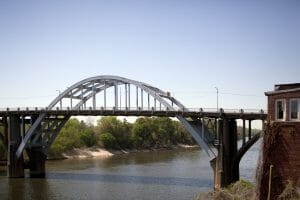Today you will start by seeing one of the absolute biggest Civil Rights historic hotspot in  the entire state, maybe the even nation, the Edmund Pettus Bridge/ Selma to Montgomery Trail. This highly iconic Through Arch Bridge carries U.S Route 80 across the Alabama River in Selma, first constructed in 1939 (opened in 1940). The bridge itself is 1,248’, though the span of influential history that has taken place in/around/on it is immeasurable. At the base of the bridge, you will find memorials dedicated to the conflict known as Bloody Sunday, the infamous day in which 600 people marched as far as this National Landmark only to be violently stopped by both state and local law enforcement members. This event happened on March 7, 1965, when the 600 marchers were heading east out of Selma hoping to make it to the capitol in Montgomery.
the entire state, maybe the even nation, the Edmund Pettus Bridge/ Selma to Montgomery Trail. This highly iconic Through Arch Bridge carries U.S Route 80 across the Alabama River in Selma, first constructed in 1939 (opened in 1940). The bridge itself is 1,248’, though the span of influential history that has taken place in/around/on it is immeasurable. At the base of the bridge, you will find memorials dedicated to the conflict known as Bloody Sunday, the infamous day in which 600 people marched as far as this National Landmark only to be violently stopped by both state and local law enforcement members. This event happened on March 7, 1965, when the 600 marchers were heading east out of Selma hoping to make it to the capitol in Montgomery.
Just two days later MLK Jr joined the effort and the march was tried again, this time Federal District Judge Frank Johnson Jr. in no way denying the right to mobility. On the 21st 3,200 people marched 12 miles, ending on the 25th with over 25,000 people. Just under 5 months after the events on this iconic trail Lyndon Johnson passed the Voting Rights Act of 1965, making all the efforts and troubles worthwhile for all those involved (and not involved as well).
In 1996 the Selma to Montgomery National Historic Trail was officiated by Congress under the National Trails System Act of 1968, officially making this an ‘All American Road’ and giving it the highest tribute and standard of routes in the U.S. While there are few actual tours of the trail and bridge, teachers and group leaders may easily find classroom plans from Teaching with Historic Places (TwHP) online, a tool that helps ‘enliven history, social studies, geography, and civics’ through Nationally Registered Historic Places.



